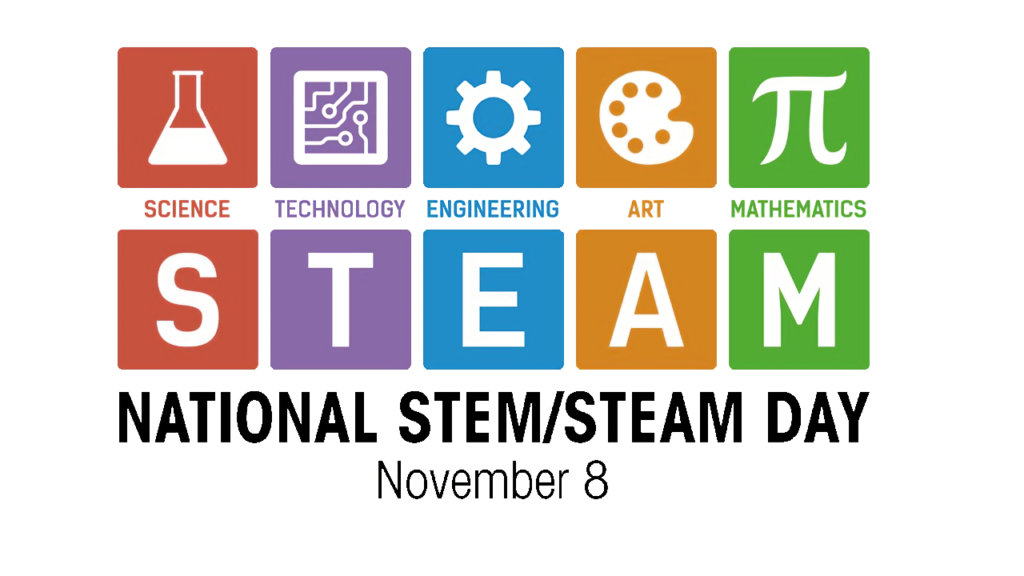Traditionally, educators focused on the three Rs — reading, ‘riting, and ‘rithmetic. While those topics remain essential, more recently educational curriculums have placed a strong emphasis on STEM, which stands for Science, Technology, Engineering, and Mathematics. Fearing a purely technical education might not produce well-rounded individuals, arts was added to the acronym making it STEAM. Tomorrow, STEM/STEAM education is celebrated across the nation. “Every November 8,” explains the staff at Mathnasium, “the fields of science, technology, engineering, arts and mathematics take the spotlight for National STEM/STEAM Day. By celebrating the ways in which STEM/STEAM affects our lives and our world, we’re able to show children how important it is to study these fields and to be aware of their impact. This can be done both at school and at home through interactive games and activities, an exposure to the vast array of STEM/STEAM jobs out there, and a deep look at the intricate world around them. The goal is to heighten the awareness and enthusiasm in students so that they are inspired to pursue these fields of study in their own careers. Because our future depends on it!”[1] They’re correct. The world is becoming more technical every day and the countries whose workforces embrace STEAM education will be the most prosperous and secure.
History of National STEM/STEAM Day
National STEM/STEAM Day was the inspiration of the Project Mc² brand, created by MGA Entertainment. The November 8 date was selected as a nod to a fictional elite international organization of female operatives from around the world known as NOV8 (pronounced “en-novate”). They are tasked to protect the world from harm.  The staff at National Day Calendar observes, “The November 8th date is a play on words for that super-secret organization, NOV8, making it the perfect date to inspire innovation!.”[2] The first celebration of National STEM/STEAM Day was held in 2015. The reference the all-female NOV8 group is also important because there is a gender gap in STEM fields. The National Day Calendar staff insists, “We must close the gender gap that exists in STEM/STEAM. related-careers. Building interest in girls is critical to their future earning potential.”
The staff at National Day Calendar observes, “The November 8th date is a play on words for that super-secret organization, NOV8, making it the perfect date to inspire innovation!.”[2] The first celebration of National STEM/STEAM Day was held in 2015. The reference the all-female NOV8 group is also important because there is a gender gap in STEM fields. The National Day Calendar staff insists, “We must close the gender gap that exists in STEM/STEAM. related-careers. Building interest in girls is critical to their future earning potential.”
They go on to note, “The U.S. has fallen behind other nations in science and math education; we need to motivate young kids to pursue these subjects to keep up with the rest of the world.” Our future, and our children’s future, depends on it. Kerry Ebersole Singh, Executive Vice President, Chief Talent Solutions and Engagement Officer at the Michigan Economic Development Corporation, explains, “With the emergence of generative artificial intelligence, there’s a lot of hand-wringing about how AI and automation will eliminate jobs. I like to look at this issue from another perspective. These and other powerful, innovative technologies will also create a lot of jobs. Both things can be true, but one thing is clear: careers in science, technology, engineering, and math will play a central role in the future of work. According to the U.S. Bureau of Labor Statistics, STEM occupations, which include life and physical sciences, are projected to grow 10.8% by 2032, more than four times faster than non-STEM occupations.”[3]
The Importance of STEM/STEAM Education
Professor Joseph Lathan, Director of Online Programs at University of San Diego School of Leadership & Education Sciences, believes STEAM education is critical for success in the twenty-first century. He writes, “According to the U.S. Department of Education, ‘In an ever-changing, increasingly complex world, it’s more important than ever that our nation’s youth are prepared to bring knowledge and skills to solve problems, make sense of information, and know how to gather and evaluate evidence to make decisions.’ Enhancing such skills lies at the heart of STEM and STEAM education.”[4] There is an old proverb: “Tell me, I forget. Show me, I remember. Involve me, I understand.” STEAM education reaches for understanding.
Lathan explains, “STEAM is an educational discipline that aims to spark an interest and lifelong love of the arts and sciences in children from an early age. Science, Technology, Engineering, the Arts and Math are similar fields of study in that they all involve creative processes and none uses just one method for inquiry and investigation. Teaching relevant, in-demand skills that will prepare students to become innovators in an ever-evolving world is paramount, not only for the future of the students themselves but for the future of the country. STEAM empowers teachers to employ project-based learning that crosses each of the five disciplines and fosters an inclusive learning environment in which all students are able to engage and contribute.” The staff at Arduino lists eight benefits of a STEAM education.[5] They are:
1. Collaborative approach. “Instead of competing with each other, the students are taught to learn to collaborate, especially when it comes to projects. They learn how to contribute their knowledge, skills, and talent in achieving common goals, and are prepared to become team players at work.”
2. Encourages creativity. “Instead of merely following fixed instructions or steps, students are encouraged to develop their own methods of solving problems or accomplishing a project. The STEAM curriculum emphasizes the fact that there are many possible approaches to problem-solving. It allows the students to use not only their technical knowledge, but also their imagination.”
3. Improves social skills. “Since the STEAM curriculum has a holistic collaborative approach, it also helps improve students’ emotional intelligence and social skills. They learn how to work with others and be expressive, and to become more socially adaptable. They will be able to deal with various types of personality and cultural background. Empathy, leadership, and friendship are also developed in this process.”
4. Exposure to multimedia and multiplatform education. “Students will not only learn about laboratory equipment or scientific instruments, they will also be exposed to various media and platforms. These will include various art materials, digital tools, hardware, machines, and different methods. For example, a student can learn how to use CAD when designing a building or machine.”
5. Critical thinking skills. “Critical thinking is about the ability to examine the factual and logical merit of a new set of information, and form a rational and informed opinion about certain issues. It’s about weeding out irrelevant and misleading information. Being able to transcend personal biases and avoiding irrational dogmatism are important in developing critical thinking skills.”
6. Boosts curiosity. “Students are encouraged to be inquisitive and curious about a wide range of topics. They are trained to ask deeper questions about how and why things work. This is the boundary between the humanities and the natural sciences.”
7. Real-world applications. “Students are taught not only theoretical and academic concepts, but more importantly, real-world applications of their knowledge and skills. Even when it comes to abstract mathematical concepts, students can be taught how to apply them in real life situations, such as household budgeting for instance.
8. Computational and logical skills. “The integration of the arts in science-oriented curriculum enhances students’ computational and logical skills. Other factors are considered aside from technical aspects. For example, when it comes to solving the problem of climate change, it requires a multidisciplinary approach but also includes significant socioeconomic and geopolitical considerations. Hence, ‘computation’ must factor in other subtle and indirect variables when solving problems.”
Concluding Thoughts
Singh concludes, “If our kids are not adequately prepared to take on the jobs for tomorrow, the U.S. faces challenges to its growth and progress. The STEM gap creates a shortage of skilled workers that employers will need to compete globally, especially as our society relies further on technology and science for innovation and success. The gap could negatively impact economic growth over the long term as well.” The Arduino staff adds, “The importance of STEAM education can’t be overstated, especially when it comes to preparing students for the real-world challenges. The integrated and holistic approach of STEAM education makes the students more adaptable to a wide range of situations and challenges.” It has been said that in today’s business environment, every company is a digital company. Whether you’re an educator, a parent, a business person, or a public servant, supporting STEAM education is important.
Footnotes
[1] Staff, “Why We Celebrate National STEM/STEAM Day and 5 Ways to Observe It,” Mathnasium, 8 November 2023.
[2] Staff, “National S.T.E.M./S.T.E.A.M. Day,” National Day Calendar.
[3] Kerry Ebersole Singh, “Preparing Kids For The Jobs Of Tomorrow: Investing In STEAM Education,” Forbes, 4 February 2024.
[4] Joseph Lathan, “Why STEAM is so Important to 21st Century Education,” University of San Diego,
[5] Staff, “8 Benefits of STEAM Education,” Arduino.





